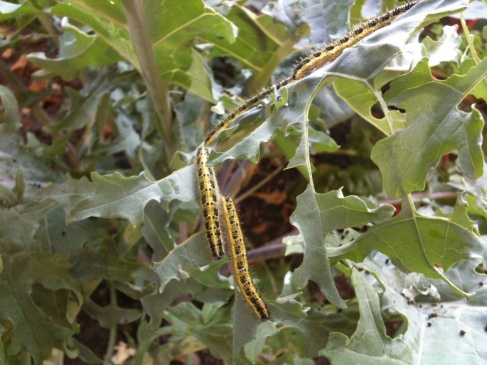I’ve started a new monthly blog over at the excellent Hackney Citizen. I’m focusing on all aspects of gardening but with an emphasis at the moment on gardening for wildlife as I think this is what we need to put our efforts into – along with protecting and promoting green spaces. My first column was inspired by the frightening reports of the crash in insect numbers in the last 30 years. Once they’ve gone, we’re up the creek. You can read the article here 
Category: Insects
Bumblebee Action In The Garden
Caterpillars – Love ’em, Hate ’em, Live with ’em
It’s hard to hate the caterpillar. Maybe because there’s something Alice In Wonderland about it or because it’s such an odd word. Maybe because it is often hairy and not slimy like slugs or creepy like earwigs or because of its alien-like (or are aliens like caterpillars?) life-cycle; they go from the egg to larva (the caterpillar) to pupa (chrysalis) to the butterfly (which delights us all) and carry on like that ad infinitum. David Attenborough told us in July that butterflies were having their worst year since the 70s ( http://www.guardian.co.uk/environment/2012/jul/12/david-attenborough-butterfly-count ), though apparently not these cabbage butterflies (see the happy collection of their caterpillars below).
Caterpillars can do a lot of damage to leafy plants and organically-inclined gardeners have a constant battle with wanting to save our precious brassicas (kill the caterpillar!) and wanting to save the planet (don’t kill the caterpillar!). The one in the picture above (soon to be/previously a cabbage butterfly) has decided, with its friends or relatives, to vary its diet and feast on nasturtiums. Caterpillars can get through a lot of leaves, and that inhibits the plants’ ability to photosynthesise. It also means there is less leaf for you to eat.
I’m willing to sacrifice the nasturtiums (they are strangling my herbs anyway) and even the kale (who needs kale in summer?) but not my red cabbage. So what do I do? What I should have done, the organic gardener’s first resort, is to check the leaves more often so that I could spot and squish the eggs. I could also have killed the caterpillars at this stage and then composted them. I was too squeamish for that. The last resort would be to spray with a microbial pesticide which contains living micro organisms (such as bacillus thuringiensis Bt) which will kill the caterpillar through its gut. It is safe for other insects, so less damaging environmentally than usual pesticides. But I’m not going to do that. My airy fairy idea is that this caterpillar population explosion will provide delicious and nutritious food for birds and beetles and that a balance between the caterpillar’s role as pest and and as food will come.
Ladybirds
This is a ladybird larva. Not a bit like a ladybird, so don’t mistake it for a pest like an asparagus beetle (I’ve done that). Ladybirds, most people know, are excellent predators – eating aphids, mealybugs, scale insects, whiteflies, mites and other insects. Their larvae are even better. In the weeks it takes for them to develop, one larva can eat 500 aphids before pupating. The aphid (black and greenfly) are menaces – sucking the life out of beans and brassicas. A single cabbage aphid has the potential to produce 1,560,000,000,000,000,000,000,000,000 more aphids (I don’t know who counted them), though, for various reasons, this never happens. One of the reasons is, of course, the ladybird.
Even if your broad beans are sucked of life by aphids, don’t be tempted to use pesticides. They can make the problem worse. The pests will eventually adapt or become resistant to the chemicals and you might end up killing beneficial insects – such as ladybirds – as well. Chemicals also destroy the organisms in the soil that transform rotting material into food for your plants so that you need to rely increasingly on fertilisers and more pesticides. So, you need to encourage the good bugs by giving them the habitats and plants they like – basically plant a good variety of plants and leave wild patches. The plants will drop their leaves which provide places for ladybirds to overwinter. It’s essential to have nooks and crannies for ladybirds to lodge in so that they stay in the garden. If they find a good hibernation site their numbers will increase. Useful plants are ones that form basal rosettes, such as mulleins and evening primrose, umbellifers such as fennel, and plants with dense foliage such as brambles and ivy.
You can probably tell I have referred to A Book or two. One is called Pests by Charlie Ryrie and the other is Ladybirds, Natural Pest Control by Darren J Mann.








